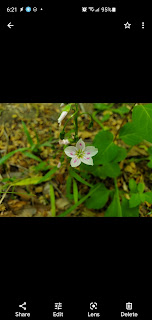Last weekend we hiked the BROT. Peeking out at the base of a tree I saw this little guy:
What the heck is it?
Or consider this beauty right here. It's obviously what would be called a wildflower, but what plant is it specifically?
And check out the funky leaves of this plant. The dark green and pronounced vein pattern reminded me of spotted wintergreen. Was this spotted wintergreen or a relative?
I wouldn't consider a hike a success if I didn't walk away with a heap of question like these. And thanks to Plant Snap and Google Images it's usually possible to get them answered.
Using a new tool, however, I was able to untangle these mysteries in a single click. Here's what I learned:
Pic 1 is Conopholis americana, known as American Cancer Root, Squawroot or Bear cone. I was right to be confused as it "is a fully parasitic plant that occurs only where it can grow attached to the roots of some species of oak." It has no chlorophyll, hence the lack of any green. Technically, the plant is edible, though reports suggest it tastes awful. The name 'squawroot' is derived from the medical benefit related to treating menopause and other lady ailments.
Pic 2 is the aptly named Virginia Spring Beauty. Apparently, they are tasty:
In his book "Stalking The Wild Asparagus" Gibbons wrote about eating them daily if not twice a day for several weeks. He said: "We tried them fried, mashed, in salads, and cooked with peas, like new potatoes. All these ways were completely successful, but, as regular fare, we preferred them just boiled 'in the jackets.' My friend grew so fond of this food that he was afraid he would experience withdrawal symptoms when the supply was exhausted." While Gibbon's friend thought they tasted like potatoes Gibbons thought they were sweeter, closer to chestnuts in flavor.
Pic 3 is most definitely not Spotted Wintergreen, and when comparing the two photos they don't look anything alike. What I found is Hieracium Venosum, known as Hawkweed or Rattlesnake Weed. Apparently, it gets it name as it thrives where rattle snakes occur. (Though no, there are no rattle snakes on the BORT). While it may have some medical benefits, they appear to be relatively obscure.
So how did I figure all this out so quickly? Why Google, of course. Specifically using Google Lens. Below are what happens when I click the "lens" button in Google Photos for these examples:
I suppose I shouldn't be surprised that Google can find web pages that contain photos that are a close match to these examples. But still, to see it in action it's hard not to be blown away.
So next time you're out and about and see some strange looking plant, give Google Lens a try. I think you'll be amazed with what you can learn.












No comments:
Post a Comment